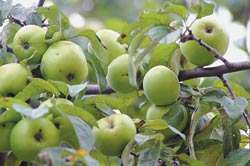Antonovka
Antonovka, Антоновка, or Antonówka is a group of late-fall or early-winter apple cultivars with a strong acid flavor that have been popular in Russia (Soviet Union and the Russian Empire) as well as in Poland and Belarus. The most popular Russian variety is Common Antonovka (Антоновка обыкновенная), from which other cultivars derive. It was developed by pioneer Russian naturalist and plant breeder Ivan V. Michurin at his experimental orchard in the Tambov Oblast and introduced in 1888.[2]
| Malus pumila 'Antonovka' | |
|---|---|
 Antonovka Apple | |
| Species | Malus pumila |
| Hybrid parentage | Seems unknown[1] |
| Cultivar | 'Antonovka' |
| Origin | |
Polish varieties
Poland has two varieties: Antonówka Zwykła (same, as in Russia) and Antonówka Biała also known as Śmietankowa (Antonówka White or Creamy) with considerably larger and whiter fruit ripening in late September, but also a shorter shelf-life.[3]

The Antonovka can withstand cold winters
Its popularity is explained by the Antonovka tree's ability to sustain long harsh winters typical for some regions of Eastern Europe and Russia and for its superior fruit preservation qualities. Sometimes nicknamed "the people's apple" (народное яблоко), the Russian variety was especially popular among the dacha owners, and remains widely grown at dachas in many Post-Soviet states.
Uses of the Antonovka
Due to the relatively low ratio of sugars in the fruit, Antonovka apples are especially well-suited for apple pies and late apple wine. The taste of the wine is noticeably lighter than wine from sweeter cultivars. In Poland, Antonówka is used mostly for apple preserves.

The cultivar of Antonovka
Antonovka is a cultivar of vernacular selection, which began to spread from Kursk region of Russia in the 19th century.[4] While the fruit-bearing trees have not received a wide recognition outside the former Soviet Union, many nurseries do use Antonovka rootstocks, since they impart a degree of winter-hardiness to the grafted varieties.
Culture
Ivan Bunin's early short story, Antonov Apples (1900), is a kind of ode to this apple cultivar as a lyric metaphor to the departing world of Russian landed gentry.
On August 19, 2008 the monument to Antonovka apple was unveiled in Kursk. The sculpture was by Vyacheslav Klykov and has a diameter of 1.5 meter.[5]
See also
References
- "Patriotic apples". newtimes.ru. September 26, 2011. Archived from the original on October 5, 2011.
- Goncharov, N. P. (2016), "Ivan V. Michurin: On the 160th Anniversary of the Birth of the Russian Burbank", Russian Journal of Genetics: Applied Research, 6 (1): 105–127
- Mgr Marta Dziubiak, SADOWNICTWO: "MODA NA STARE ODMIANY JABŁONI (II)", Szkółkarstwo January 2005
- Elena Kalashnikova; Natalia Frolova (September 26, 2011). Патриотические яблоки (in Russian). newtimes.ru. Archived from the original on October 5, 2011. Retrieved November 8, 2011.
- Lilia Haritonova (August 27, 2008). Куряне трогают яблоко удачи (in Russian). Newspaper «Курский вестник». Archived from the original on February 3, 2012. Retrieved November 1, 2011.
- "List of Apple Cultivars". List of Apple Cultivars. botanycourse.com. Archived from the original on November 20, 2018. Retrieved November 19, 2018.
External links
| Wikimedia Commons has media related to Antonovka. |
- "Antonovka", National Fruit Collection, University of Reading and Brogdale Collections, retrieved October 18, 2015
- Beach, S.A.; Booth, N.O.; Taylor, O.M. (1905), "Antonovka", The apples of New York, 2, Albany: J. B. Lyon, pp. 6–6
